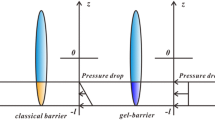Estimates show that carbonate reservoirs contribute to 60% of the world’s total oil and gas production, where fractured reservoir bodies are the most widely and commonly distributed. Among all materials for plugging fractured reservoir bodies, gel plugging agent is very suitable, for which can solve the problems of rapid increase of water cut and rapid production reduction of wells. However, the plugging mechanism of gel plugging agent in fractured carbonate oil reservoir is still unclear. In this paper, AM/AMPS phenolic gel was prepared. Besides, a microscopic visualization research system of fractured-vuggy carbonate reservoirs was designed and established independently, and the fractured core model was self-made. Through the core flow test and microscopic visualization experiment, the plugging performance and mechanism of gel plugging agent in fractured carbonate oil reservoir were thorughly studied. The results demonstrated that AM/AMPS phenolic gel has selective plugging performance in fractures. After the system is gelled, it mainly plugs the water-bearing layer, with a water plugging rate as high as 99.82 %, and basically does not plug the oil-bearing layer, with an oil plugging rate of only 11.7%. It can be known that gel plugging agent has a plugging mechanism of mainly “inhibiting high-permeability reservoirs and unclogging low-permeability reservoirs”, and it is characterized by “plugging without stopping”. As a result, it can slowly migrate through high-permeability reservoirs and form a re-plugging.














Similar content being viewed by others
References
Huaiyou Jiang, Xinmin Song, Yuanji Wang, et al. Current Situation and Prospects of World Marine Carbonate Oil and Gas Exploration and Development[J]. Offshore Oil, 2008, 28(4): 6-13.
Perez-Rosales C, Mercado-Diaz A, Cruz-Hemandez. Electric resistivity of vuggy fractured media[J]. SPE 74340, 2002.
Wu Y-S,Di Y,Kang Z,et al. A multiple-continuum model for simulating single-phase and multiphase flow in naturally fractured vuggy reservoirs[J]. Journal of Petroleum Science and Engineering, 2011, 78(1): 13-22.
Yongqiang Li. Quantitative characterization of internal heterogeneity of carbonate fracture-cavity units in Tahe Oilfield[D]. Beijing: China University of Petroleum (Beijing), 2017: 8-10.
Tian F, Ji Q, Lu X, et al. Multi-layered Ordovician paleokarst reservoir detection and spatial delineation: A case study in the Tahe Oilfield, Tarim Basin, Western China[J]. Marine and Petroleum Geology, 2016, 69(2): 53-73.
Molnes S N, Torrijos I P, Strand S, et al. Sandstone injectivity and salt stability of cellulose nanocrystals (CNC) dispersions-Premises for use of CNC in enhanced oil recovery[J]. Industrial Crops and Products, 2016, 93: 152-160.
Zhao G, Dai C, Zhang Y, et al. Enhanced foam stability by adding comb polymer gel for in-depth profile control in high temperature reservoirs[J]. Colloids & Surfaces A Physicochemical & Engineering Aspects, 2015, 482:115-124.
Sakthivel S, Velusamy S, Nair V C, et al. Interfacial tension of crude oil-water system with imidazolium and lactam-based ionic liquids and their evaluation for enhanced oil recovery under high saline environment[J]. Fuel, 2017, 191:239-250.
Bai Y., Xiong C. Wei F. Gelation Study on a Hydrophobically Associating Polymer /Polyethylenimine Gel System for Water Shut-off Treatment[J]. Energy Fuels, 2015, 29(2): 447-458.
Wenjing Liu, Han Jia, Jinyuan Cao, et al. Development and performance evaluation of a delayed cross-linked chromium jelly[J]. Oilfield Chemistry, 2016, 2(33): 235-239.
Chen Lifeng, Zhu Xiaoming, Wang Lei. Experimental Study of Effective Amphiphilic Graphene Oxide Flooding for an Ultralow-Permeability Reservoir[J]. Energy & Fuels, 2018, 32(11): 11269-11278.
Chen, Lifeng; Zhang, Quan; Fu, Meilong. Experimental Investigation on the Nanosilica - Reinforcing Polyacrylamide/Polyethylenimine Hydrogel for Water Shutoff Treatment[J]. Energy & Fuels, 2018.06, 32(6): 6650-6656.
Koohi A D, Seftie M V, Ghalam A. Rheological characteristics of sulphonated polyacrylamide/chromium triacetate hydrogels designed for water shut-off[J]. Iranian Polymer Journal, 2010, 19(10): 757-770.
Almohsin A, Bai B J, Imqam A, et al. Transport of nanogel through porous media and its resistance to water flow[R]. SPE 169078, 2014.
Lig F, Xiang Y, Shen H S. Temperature dependent me-chanical properties of graphene reinforced polymer nanocomposites—A molecular dynamics simulation [J]. Composites Part B: Engineering, 2017, 111: 261-269.
Sun X, Bai B. Comprehensive review of water shutoff methods for horizontal wells[J]. Petroleum Exploration and Develpo-ment, 2017, 44(6):1022-1029.
Al-Muntasheri, G A; Nasr-El-Din, et al. A Rheological Investigation Of A High Temperature Organic Gel Used For Water Shut-Off Treatments[J]. Journal Of Petroleum Science & Engineering, 2007, 59(2): 73-83.
Jayakumar S., Lane R. H. Delayed Crosslink Polymer Gel System for Water Shutoff in Conventional and Unconventional Oil and Gas Reservoirs[C]. SPE 164046, 2013.
Zhang Cai, Li Cheng, Wang Bai, Liu Sun. Experimental study of acrylamide monomer polymer gel for water plugging in low temperature and high salinity reservoir [J]. Energy Sources, Part A: Recovery, Utilization, and Environmental Effects, 2018, 40(24): 2948-2959.
Acknowledgements
Financial support by the 2022 Scientific Research Program Funded by Hubei Provincial Department of Education, funding project number: Q20222902.
Author information
Authors and Affiliations
Corresponding author
Additional information
Translated from Khimiya i Tekhnologiya Topliv i Masel, No. 3, pp. 76–82 May – June, 2023.
Rights and permissions
Springer Nature or its licensor (e.g. a society or other partner) holds exclusive rights to this article under a publishing agreement with the author(s) or other rightsholder(s); author self-archiving of the accepted manuscript version of this article is solely governed by the terms of such publishing agreement and applicable law.
About this article
Cite this article
Li, X., Su, L., Fu, M. et al. Study on Plugging Mechanism of Gel Plugging Agent in Fractured Carbonate Oil Reservoirs. Chem Technol Fuels Oils 59, 507–516 (2023). https://doi.org/10.1007/s10553-023-01552-2
Published:
Issue Date:
DOI: https://doi.org/10.1007/s10553-023-01552-2




